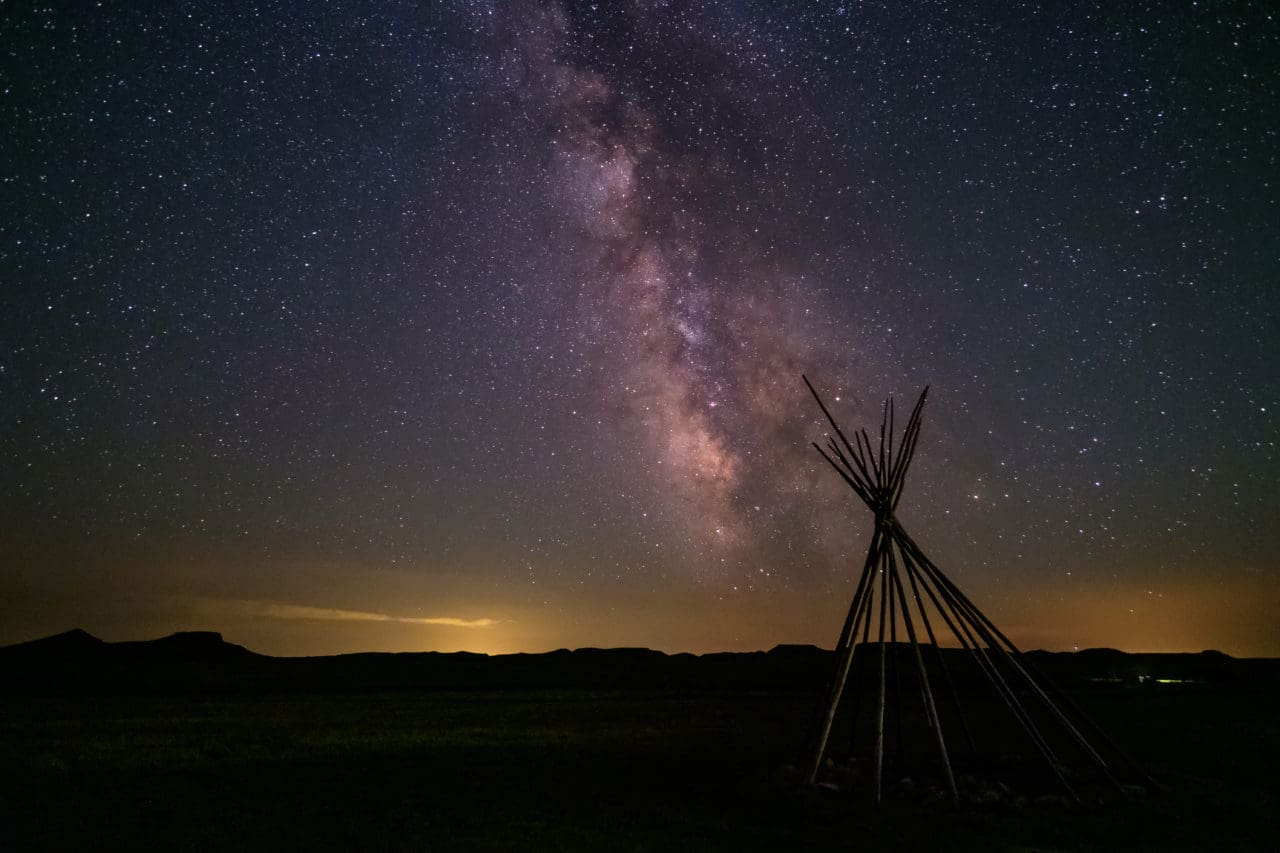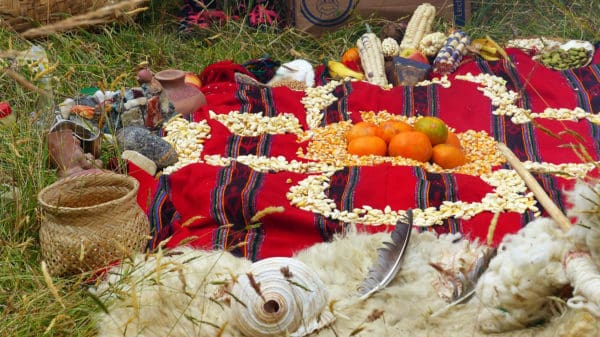In recent years, many people have pointed to peyote’s religious exemption and argued that any psychedelic that facilitates mystical experiences should be made legal for religious and spiritual use. But these arguments, while perhaps intuitive and rational, may lack some social and historical context. This article hopes to offer a little support in that regard. (See also, “Should we really be decriminalizing Peyote?“)
Let’s be clear from the get-go: peyote is a naturally occurring but critically threatened sacramental cactus that produces mescaline, the same psychoactive compound found in San Pedro cactus; the very compound that inspired the very term “psychedelic.” Without peyote, the Psychedelic Renaissance as we know it would never have happened.
From today’s (slightly) more progressive standpoint, the idea that peyote should be protected as part of our right to religious freedom may seem both intuitive and logical. But this was not always the case, and in fact, Native Americans were persecuted and killed for using peyote in ceremony, which settlers could only conceive of as an evil narcotic, rather than as the healing medicine and sacrament it was known to be among those who practice Peyotism faith of the Native American Church (NAC).
Before we dive into the details of the legal history of peyote, let’s establish some groundwork around settler relationships. Because, without a bit of grounding, we might miss some important points of peyote’s legal history.
Policy Discussions From the Heart
When settlers first begin to engage in discussions about decolonization and Native American genocide, they frequently experience unprocessed feelings of guilt, shame, and righteousness. While these feelings are valid, they are better resolved before engaging in policy discussions about peyote.
By working through one’s ancestry and learning more about who we are and where we come from, we are better equipped to have a conversation about settler colonialism and the impact of peyote laws on religious freedom. Without having some awareness of our own roots, or grounding in our own sense of place, we can run into problems of romanticization and tokenizing of indigenous cultures, relying on media portrayals or tropes. For example, many falsely assume that Native Americans only live on reservations in tipis, but over three-quarters live outside of reservations in cities throughout what is now called the United States.
This brief exercise can be helpful when considering the use of any sacred plant medicine. However, it is especially important for the United States, where peyote is critically threatened, and religious freedom is still in question.
Where Are You?
Before we jump into the legal history of peyote in the United States, take a minute to visit native-land.ca. Figure out quickly where you’re at and what land you’re living on. Note the original stewards and the languages spoken and do a little research to see the status of the tribe currently. Are some fully recognized tribes? Or are they unrecognized? Where is the local Tribal Authority located? If you have an extra minute, look up where your parents and grandparents lived in the United States (if this applies), and do the same.
The point of this exercise is to remind us that we walk and live on stolen land. The United States is a colonial nation that has yet to reconcile its history of conquest, and this history is interwoven with past and current peyote policy discussions.
Federal Legislation That Impacted Peyote Use
Before peyote was exempted from the Controlled Substances Act in 1970, there were several pieces of legislation detailing the rights of Native Americans and religious sacraments and ceremonies.
This list is not exhaustive, but we hope it is a start:
The Bureau of Indian Affairs is Established in 1824
Before the BIA was its own department, Congress operated the Office of Indian Trade beginning in 1806. The “Indian Office” was housed within the War Department. Traders were licensed to have a level of control over territories and to earn commission while overseeing things on behalf of Congress. By 1924, the office became the Bureau of Indian Affairs. Throughout the department’s evolution, several Native leaders would come to serve in directorial positions and were tasked with maintaining relations with Tribes.
The 1830 Indian Removal Act
In 1829 a gold rush emerged in Georgia, driving up land speculation and attracting settlers. After Southern states attempted to draft their laws to extinguish land titles among Native Americans, President Andrew Johnson signed the Indian Removal Act. In an act of genocide, this measure funded the forced relocation of several Native American Tribes from their ancestral lands in the South East to territories West of the Mississippi. Some organizers and missionaries protested the act. It was heavily debated in Congress before ultimately passing with 28 in favor and 19 opposed. The “forced removal” process lasted over a decade and would go on to be known in U.S. history as the Trail of Tears.
Once on Indian Territory land, the Tribes were told they would be left alone to self-rule, but this was not the case. It was through the intertribal relationships that Peyotism emerged and was shared. There were similarly forced migrations of indigenous populations in the North, with several cases related to land captures and broken treaties.
The Religious Crimes Code of 1883
As the United States government and its growing population continued to push westward, another violent ideology emerged alongside Manifest Destiny, that of cultural assimilation. The United States Congress passed the Code of Indian Offenses, establishing a Court of Indian Offenses that allowed the U.S. government to interfere with criminal justice in sovereign nations, enforcing laws designed to “civilize” Native Americans. This would prove to be an act of cultural genocide.
Punishable offenses included gathering together, dancing, singing, using drums, giving gifts, carrying ceremonial items, and practicing any cultural custom that was seen as ”uncivilized.” Settlers even targeted the Potlatch ceremony common to many tribes of the Pacific Northwest. The word “potluck” comes from the traditional potlatch that remained illegal in Canada until 1951, but then, the ritual practice of resource sharing was seen as detrimental to the nation’s character. Peyote ceremonies were not permitted.
The Dawes Act of 1887
In continued efforts toward assimilation, the United States government initiated a measure to break up remaining Tribal territories into individual parcels that Native Americans were expected to use for farming and agriculture, never mind that farming was not practical on the lands provided. The Army and hunters drove the bison to near extinction to make room for cattle ranching and simultaneously try to make some Tribes dependent upon the settlers for food and resources. In total, the United States government claimed another two-thirds of the remaining Sovereign land base through legislation that fractured families and tribal leadership.
If Native Americans complied, the U.S. would grant citizenship rights. If they did not, the U.S. would sell the allotments of tribal land to non-Native citizens at a fraction of the cost. The act was another effort at assimilation, forcing European American agricultural practices onto Native American tribes. This Act also formed the basis for the use of “blood-quantum” (aka the “amount” or ratio of Native American “blood” as defined through genealogy) as a means of establishing federally recognized tribal membership, a necessary precursor for gaining rights and access to programs and religious protections for sacramental peyote.
The Indian Reorganization Act of 1934
At the turn of the century, the United States began to address drug laws internationally and nationally. The Pure Food and Drug Act was passed in 1906, paving the way for the Harrison Act of 1914 that would threaten the traditional use of peyote and peyote ceremony. Up until this point, Peyotism was practiced in the safety and isolation of the tipi, the one place where Federal interference seemed to stall.
But, settlers consistently saw peyote as a narcotic rather than the sacrament it is. Parke-Davis, a pharmaceutical company in Detroit, sold peyote tincture as a stimulant as early as 1893. Researchers were using peyote in human trials to try and mimic schizophrenia as early as 1913.
In 1928, the Federal government commissioned the Meriam Report to investigate the state of health on the reservations. Amidst reservation schooling and the intergenerational effects of genocide, the report made clear that Congress had failed to protect the wellbeing of Native American Tribes on reservations. Part of President Roosevelt’s New Deal, was the American Indian New Deal, whose main goal was to reverse the impact of the Dawes Act. As part of this effort, John Collier issued a mandate that no “interference with Indian religious life or ceremonial expression will hereafter be tolerated. The cultural liberty of Indians is in all respects to be considered equal to that of any non-Indian group.”
The Indian Civil Rights Act of 1968 and Peyote Exemption to the CSA in 1970
The American Indian Movement (AIM) was founded in Minnesota in 1968 during the period of social reform preceding the Controlled Substances Act. Even after generations of colonization and attempts at legal protections, settlers continued to commit acts of racism and harassment, as did law enforcement personnel and courts that sanctioned U.S. families to adopt Native American children without consent from Tribal authorities. The American Indian Movement was deeply involved in activism and advocacy for civil rights and religious protections, and some protections were granted in the Civil Rights Act of 1968.
AIM engaged in public actions to draw awareness to the realities of settler injustice against Native Americans, especially in response to further assimilation measures. And as the Controlled Substances Act moved forward under Nixon, Native American advocates and a handful of allies in Congress effectively argued for the exclusion of peyote from Schedule 1 for NAC ceremonial use. However, the full extent of the Bill of Rights, including freedom of religion, was not yet guaranteed under this act.
The American Indian Religious Freedom Act of 1978
Under President Jimmy Carter, Congress finally enacted legislation to explicitly extend the full rights of religious freedom to Native Americans. Known as AIRFA, these protections extended to ceremonies, access to sacred sites, ritual elements collected from sacred animals being held in every state, regardless of existing state laws. However, without a penalty provision, the act lacked any teeth or power of enforcement in the event states ignored the request and allowed construction on top of a sacred site, or mining of a sacred mountain, or logging in sacred forests, or dams on sacred rivers.
Lacking any sense of reciprocity, some states began interpreting AIRFA in ways that caused further harm to Native American Tribes, including denying the use of peyote for religious purposes.
The Religious Freedom Restoration Act of 1993 and Religious Land Use of Institutionalized Persons Act of 2000
During the 1980s, Federal courts began re-interpreting the Religious Freedom Act, suggesting that the law really did not apply to peyote, which was a Scheduled drug. Following a handful of court cases, the Supreme Court made it abundantly clear that peyote use was protected and that courts had to use “strict scrutiny” when interpreting the 1st Amendment.
A 1997 case in Texas challenged the ruling, as a Catholic church sued the city for rejecting a proposal to expand their premises on the grounds that zoning ordinances would also fall under this “strict scrutiny” of religious freedom interpretation. In response, several states ended up establishing their own versions of the religious freedom act, shifting the decision-making power around enforcement of religious freedom laws around peyote back to the state. Often called “mini-RFRAs,” these measures vary and are evolving, but most do not prioritize conversations with people who practice Peyotism.
After RFRA was struck down in 1997, Congress responded with the Religious Land Use of Institutionalized Persons Act in 2000, guaranteeing that incarcerated individuals would still be granted religious freedom when in prison. This has permitted the use of the Sweat Lodge ceremony among Native American inmates in some prisons, which has demonstrated benefit in rehabilitation.
Supporting Religious Freedom For Entheogens Means Supporting Native American Sovereignty
This article sought to offer a primer of some important legal cases and decisions that have impacted both peyote law and religious freedom in the United States. Many people who experience the spiritual benefits of psychedelic medicines argue that these experiences should be protected under the Religious Freedom Act and often point to peyote as an example to justify their argument.But as we have hopefully demonstrated in this brief, one-sided review of legislation from a settler perspective, the context of these arguments could benefit from more intentional collaboration and dialogue between all those who are impacted by prohibitive and oppressive laws. Collaboration happens in relationships, and relationships need to be consensual and reciprocal if they are to be sustainable. And in this regard, psychedelic healthcare access could be a bridge of understanding that opens up further awareness of the rights and realities of Native American tribes.
For more information, check out the Native American Rights Fund and the National Congress of American Indians. To learn more about supporting Sovereignty, take note of the Sorgorea Te’ Land Trust and the Shuumi Land Tax effort and the Land Back Movement.







